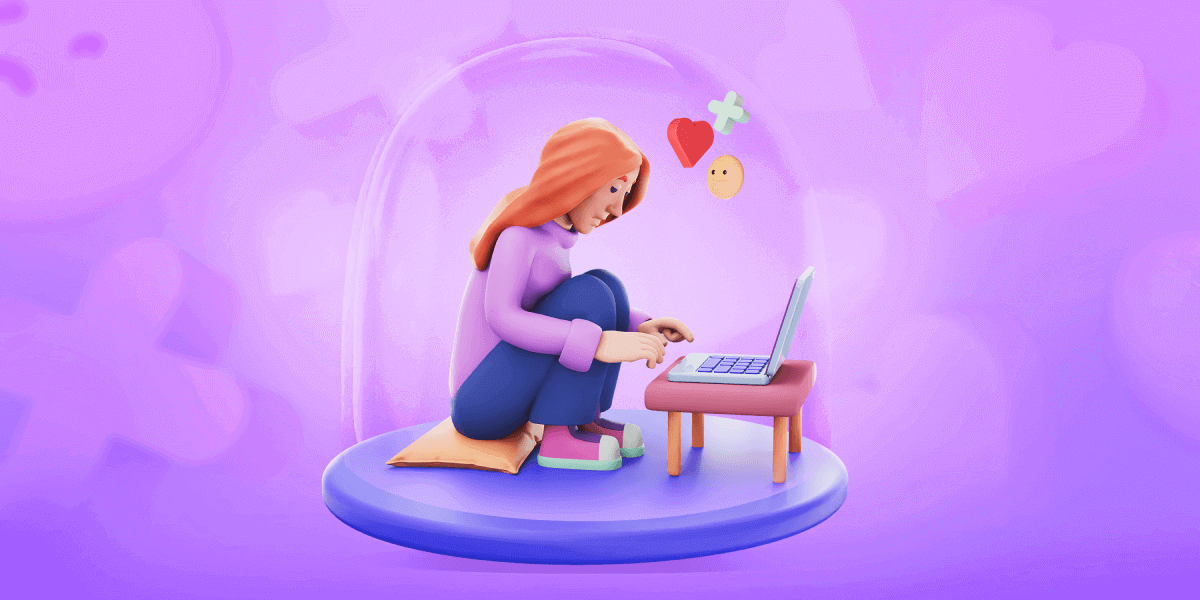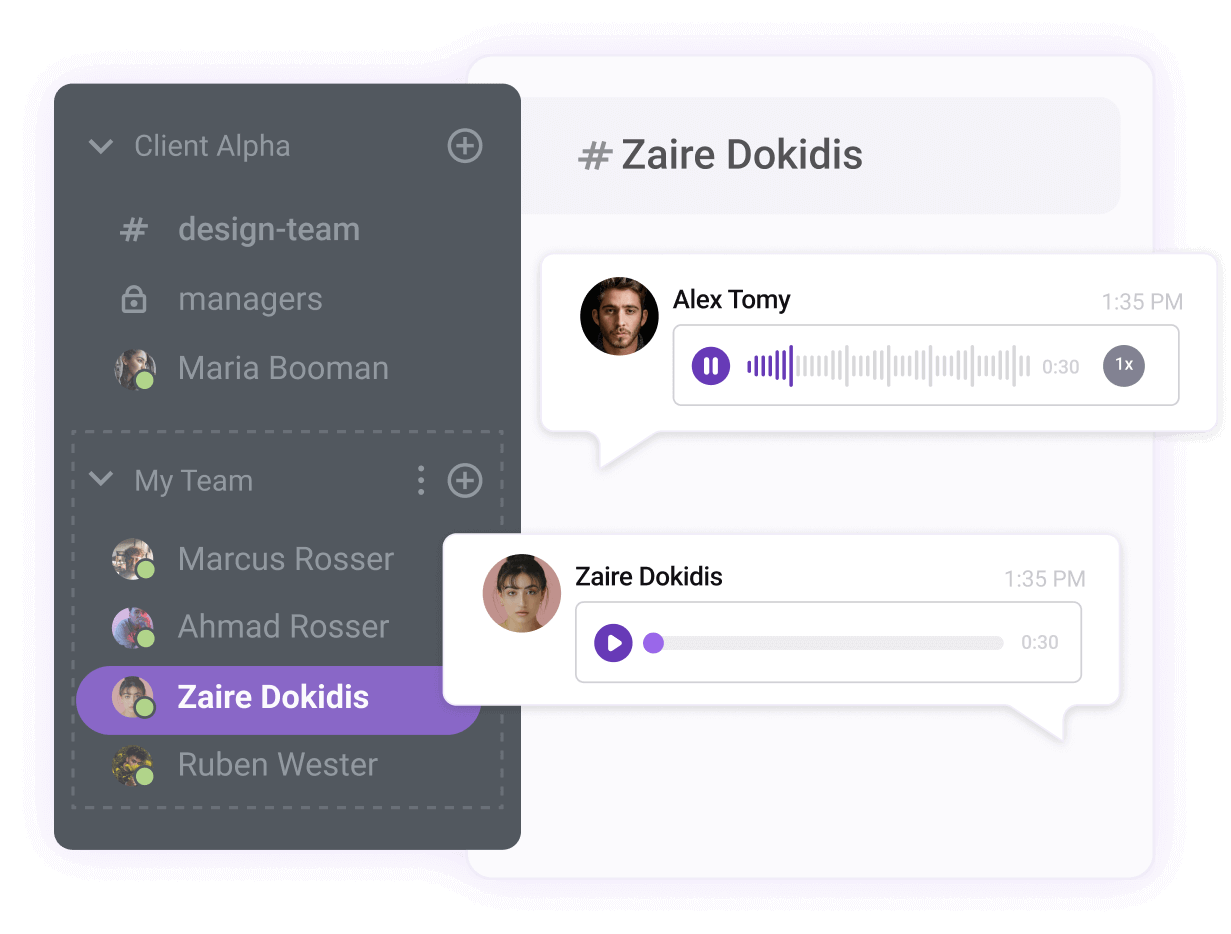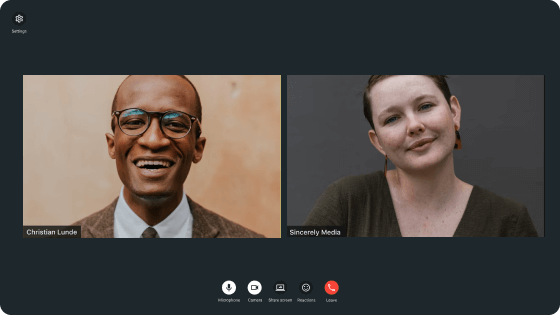Do you feel the Sunday scaries get the best of your weekends?
Are you finding it more difficult to focus and do your best job because of the stress and anxiety you feel at work?
Do you feel your company supports your mental well-being, or are you left to suffer in silence?
If so, you’re not alone. In fact, a 2021 report on workplace mental health shows that 76% of professionals report experiencing at least one mental health condition related to workplace factors.
To help you get a better understanding of mental well-being at work and find ways to protect your mental health, in this blog post we’re breaking down:
- The importance of addressing mental health in the workplace,
- Workplace factors that negatively impact employee mental health,
- The effects of poor mental well-being on employees and organizations,
- Tips on how to protect your mental health at work, and
- Ways for companies to foster mental health in the workplace.
Let’s begin!

Table of Contents
The importance of addressing mental health in the workplace
A commitment to creating a mentally strong workplace allows employees to:
- Cope with stress more easily,
- Develop agility and resilience,
- Adapt to change,
- Face challenges, and
- Maintain optimal productivity and performance.
To achieve all of this, organizations need to create safe spaces for these topics to be discussed without stigma and discrimination.
Fortunately, the pandemic and the many narrative-changing social events and movements — such as the Women’s March and Black Lives Matter movement — have helped change the discourse on the topic of mental health.
We now see a slow shift in how mental health is discussed more openly not only in close circles, but also in schools, on social media, in the mainstream media, and in the workplace.
But before we get into the ways of addressing mental health in the workplace, let’s first discuss the main workplace factors that negatively impact employee mental well-being.
Workplace factors that negatively impact employee mental health
The sad truth of the matter is — our modern workplaces are not the safest places when it comes to employee mental well-being.
According to the aforementioned 2021 research, a whopping 84% of respondents cited at least one workplace factor that had a direct negative implication on their mental health.
And, while remote and hybrid work structures brought about many benefits and have seemingly unburdened some of the cognitive and mental load, they also introduced isolation and workaholism, along with other factors hindering the mental health of remote workers.
Let’s take a closer look at some of the most common workplace factors that negatively affect the mental well-being of both in-office and remote workers.
Factor #1: Lack of health and safety policies
Company cultures that lack ample health and safety policies risk poor employee mental health. When employees don’t feel supported, heard, and protected at work, they are bound to experience a lot of additional stress, fear, insecurity, and uncertainty.
If left unaddressed for too long, these can lead to more severe mental health conditions.
Factor #2: Isolation
Isolation is one of the most common factors that negatively impact people’s mental health.
According to a review of the effects of social isolation published in the Royal Society, mental health consequences of social isolation include:
- Accelerated cognitive decline,
- Impaired executive function,
- Poor sleep quality, and
- Depression.
This is especially evident in the remote workplace.
Remote workers may enjoy the advantages of less commute and flexible schedules often connected with working from home.
However, remote work most often comes with isolation and disconnection from coworkers and company culture as a whole.
An LCSW, CASAC, and ISTDP practitioner — Marni Millet — explains how isolation and lack of connection affect the mental health of individuals, and how this can affect organizations as a result:

“People are isolated, and lack of connection in the physical space with one another is leaving a void in an empathic and emotional context. Without the energy of being within 6-8 ft of each other, the opportunity to form meaningful bonds with people you work with is limited.
This can lead to people having self-doubt, rumination, and other defenses, as they attempt to make sense of themselves. Virtual meetings are missing authenticity as it’s hard to read others and the ‘flat’ face and online personas can lead to mistrust of person, information, and productivity.”
Another one of our contributors, Faisal Tai, MD, psychiatrist and CEO at PsychPlus, agrees that social isolation is the biggest threat to the mental well-being of remote workers:

“By their very nature, humans are social beings. The vast majority of them expect and enjoy interaction with others. Sitting alone in your house all day long in front of a computer turns this natural propensity on its head.”
Factor #3: Stigma
We can all relate to the shame and fear of judgment connected to disclosing something painful and personal in an unsupportive environment. When it comes to our mental health, stigma and discrimination can have even more serious repercussions.
Workplace stigma and discrimination around mental health can have detrimental effects on people with lived experience of mental health conditions, a study shows.
In addition to avoiding work and concealing their mental health condition, people with mental health conditions experience increased work stress and decreased life expectancy when faced with stigma and discrimination regarding mental health at work.
Factor #4: Emotionally draining work
Respondents in the previously mentioned 2021 study on mental health at work, cited emotionally draining work as one of the most common workplace factors that negatively affected their mental well-being.
It’s no surprise that even the most resilient of professionals can get overwhelmed by:
- Highly stressful, boring and monotonous work,
- Long hours, and
- Lack of meaningful work and recognition.
Factor #5: Poor communication
It’s not necessarily a groundbreaking discovery that organizations that don’t prioritize clear, effective, and timely communication across all levels risk plenty of serious losses, including:
- Decreased productivity,
- Poor team collaboration, and
- A bad reputation.
However, it’s important to understand that poor communication practices also affect individuals’ well-being. Stress, tensions, continual misunderstandings, conflicts, and an overall unstable workplace environment that results from poor communication can take a toll on employees’ mental health.
Factor #6: Lack of managerial support
Workplaces that don’t nurture supportive and empathetic leadership styles are a breeding ground for poor employee mental well-being.
When people don’t feel heard, understood, supported, recognized, and guided by their direct superiors, they are more likely to feel:
- Directionless,
- Insecure,
- Unmotivated, and
- Stressed about their work performance and their role in the organization.
Factor #7: Workaholism and performance pressure
By now, we’re all aware of the benefits remote work has brought to the productivity department.
However, we can also attest to the fine line between performing at our highest capacity and feeling outright overwhelmed to meet unrealistic productivity expectations.
And, this is unfortunately where employee well-being often takes a hit. According to the latest statistics on workaholism, around 30% of the population is affected by work addiction. Some of the most common workaholism outcomes according to The American Psychological Association include:
- “Job stress
- Work-life conflict, and
- Burnout.”
Factor #8: Unsustainable ways of working
Similarly to the previous point, workplace conditions that prioritize productivity over mental well-being often have more fixed structures and rules around office hours.
This, naturally, leaves no room for a healthy work-life balance, which takes a toll on people’s mental health in the long run.
Although we’ve seen some great improvement in this area with flexible hours and asynchronous work in a remote structure, the recent return to office orders threatens to ruin this balance.
Factor #9: Discrimination
Unfortunately, we still have a long way to go when it comes to creating inclusive workplace culture, despite the growing awareness and popularization of DEIB (Diversity, Equity, Inclusion, and Belonging) strategies.
As recent studies have shown — 3 in 5 US employees have either witnessed or experienced workplace discrimination based on age, race, ethnicity, gender, or sexual orientation.
According to a study by the National Library of Medicine, the implications of workplace discrimination on employee mental well-being can be grave:
- “Diminished psychological well-being,
- Increased risk of psychological distress, and
- Pronounced depressive symptoms.”
Factor #10: Lack of tangible support and resources
In addition to managerial support, another huge factor in employee mental health is the amount of tangible support and resources available.
However, it seems like we’re still not there when it comes to implementing the relevant mental health services and resources and communicating these to employees.
According to Mind the Workplace 2022 Report by Mental Health America, less than half of respondents (47%) are aware of what mental health services they can use when they’re experiencing challenges at work. Moreover, only 38% would feel comfortable using services provided by their company for mental health conditions.
Factor #11: Job insecurity
As we’ve witnessed with the layoffs due to the pandemic, the fear caused by the potential loss of a job that provides the only resource of financial income increases the risks of major psychological distress.
Workplace environments that don’t prioritize clear and transparent communication can provide major stress and a lack of stability and security for employees.
How mental health challenges affect employees
Although we already mentioned many of the mental health challenges employees face due to different workplace factors, let’s briefly outline all the main mental health challenges in the workplace and how these affect employee well-being and performance.
Mental health challenges employees can experience in the workplace:
- Burnout — The World Health Organization defines burnout as a syndrome caused by chronic workplace stress. According to the WHO, burnout presents as “exhaustion, reduced professional efficacy, mental distance, and cynicism” among other symptoms. A 2022 study shows over 38% of participants report experiencing all three of the symptoms of burnout.
- Anxiety — Consistent pressure to perform, increased stress, and the inability to unplug after work (especially for people working from home) can all lead to developing anxiety. Moreover, virtual meetings can trigger meeting anxiety with people sensitive to cognitive overload due to long hours in on-camera meetings.
- Depression — Remote work isolation, workplace discrimination, and burnout can build up and lead to depression.
- Decreased focus — The always-on mentality, distractions, and the pressure to wear multiple hats create a breeding ground for declining focus. A whopping 71% of respondents in the previously mentioned Mental Health America report said they struggle to focus at work.
- Stress — Chronic stress is probably the most common mental health challenge connected to workplace factors, and it’s often the cause of even more severe mental health conditions.
How employee mental health challenges affect organizations
Organizations are also suffering significant consequences from poor employee mental health.
These may include:
- Higher resignation rates — Toxic workplace cultures that value performance over employee support are more likely to experience higher turnover rates. Let’s not forget the Great Resignation phenomenon that saw 4.3 million Americans leaving their jobs in November 2021 due to poor social safety measures, isolation, and poor work-life balance. In fact, the movement doesn’t show any signs of slowing down. A whopping 56% of employees surveyed by Mental Health America report having spent time looking for a new position.
- Decreased performance — Mental health challenges affect all areas of an individual’s life — from emotional and physical health, to sleep and work performance. Exhaustion and stress at work will sooner or later show up as missed deadlines, mistakes, and reduced output. A recent study investigating this connection has shown a direct correlation between employee mental health and work performance.
- Decreased productivity and engagement — Data by the World Health Organization shows that $1 trillion is lost in productivity per year globally due to depression and anxiety. Loss of focus and motivation, in addition to decreased cognitive performance and employee morale — commonly connected to mental health struggles — will undoubtedly lead to low productivity and decreased employee engagement.
- Low job satisfaction — People who experience mental health challenges at the workplace are less likely to feel content at their job — especially if these symptoms are left unaddressed by the individuals experiencing these and by their organization.
How to protect your mental health at work
Now that we understand the importance of mental health in the workplace, let’s break down some best practices on how to protect it as an employee.
Tip #1: Stick to a routine
Even if you enjoy the flexibility of remote work, you’ll still need to consider creating a routine to better cope with the stress and protect your mental health.
Consider outlining a structure for each day that includes goals, tasks, breaks, and challenges to anticipate. This helps you prepare for the day and leaves you feeling more in control.
Similarly, try to add as much routine to your off-work hours. Dedicate specific times in your day for your house chores, hobbies, workouts, meeting friends, and going out. Having more structure in your days helps you unplug faster after work and avoid burnout.
In an effort to learn more about healthy structure-setting, we spoke to Jonathan Smith, a licensed marriage and family therapist and the founder and executive director at The Center for Family Wellness. He shared how this structure can look for remote workers:

“Engage in a fake commute. Leave your house and go for a drive/walk/bus ride every morning like you did when you were working in person. Go get coffee or listen to music or just get fresh air. Do the same thing at night at quitting time. This will help demarcate your day as it does during in-person work.
If possible, create a work-only area and only do work there. The more you turn your home into an office, the harder it will be to disconnect at the end of the day.”
Tip #2: Take regular breaks
Ever got so immersed in work that you completely lost track of time and the only thing that helped you realize this was the awful feeling of complete numbness in your legs or pain in your back?
Yes. Remote work will do this to you. Working from the comfort of your home or some other comfy remote setup will trick you into forgetting that you still need to take breaks.
From there, it is a hop, skip, and a jump to developing burnout.
Regular 5-minute breaks to get up and stretch are simple but powerful ways to recharge, de-stress, and even get a new perspective on the task at hand. In addition to these, try adding a few longer breaks to go on a 20-minute walk outside, have lunch, or talk to a friend or family member.
Adding regular breaks into your daily schedule helps you:
- Create a better work-life balance,
- Prevent burnout, and
- Find space and time to apply strategies to cope with stress.
Tip #3: Set boundaries
In line with the previous points, taking regular breaks often involves boundary setting.
To be able to create a structure that prioritizes your mental well-being, you’ll need to say “No” here and there and set stronger work-life boundaries.
Setting boundaries in your professional and personal life are key to maintaining a healthy work-life balance and preventing burnout.
Our contributor, Daniela Herrera, an award-winning ED&I professional, highlights the importance of boundary-setting in protecting your mental health at work. Here’s her tip on how to get started:

“Always set boundaries that work for you and your well-being. You can, for example, make sure to block a full hour for lunch every day or block your calendar before 9 a.m. and after 6 p.m. to ensure no one is scheduling meetings during your “off work” hours. If possible, I’d also recommend taking quick breaks during the day to either walk around the block, get a snack, or take your eyes away from the computer for a few minutes.
Something else that works for many is dedicating specific times in your calendar for specific tasks and muting all notifications while you concentrate on those tasks at hand.”
Tip #4: Prioritize self-care
One of the most effective ways of dealing with workplace stress and mental health challenges is to build a strong foundation through regular self-care practice.
These can include, but are not limited to:
- Maintaining a healthy diet and creating a good sleep and exercise routine,
- Doing something you enjoy every day (favorite hobby, reading for at least half an hour, listening to music, or watching a favorite show), and
- Practicing relaxation techniques (meditation, yoga, breathing exercises).
All these are instrumental in building a strong mindfulness foundation to help you better cope with stressful situations when they occur.
Our contributor, Candace Kotkin-De Carvalho, LSW, LCADC, CCS, CCTP, and the Clinical Director at Absolute Awakenings, summed up what a self-care routine can look like for people who want to protect their mental health while working remotely:

“Prioritize self-care and make time for activities that help you recharge and stay connected with others. This might include taking regular breaks during the workday, engaging in physical exercise or meditation, spending time outdoors, connecting with friends and family, or allowing yourself some ‘me time’ to do things you enjoy. Burnout can take years off your life, so taking the steps to prevent it from happening is important.”
Tip #5: Practice self-awareness
Stepping back and paying attention to how you respond to stress and any triggers as they show up can be truly beneficial in improving your mental well-being at work and in your personal life.
Try to check in with yourself by observing your emotions and thoughts as they show up. Being mindful of your emotions helps you stop the negative momentum from taking over.
Otherwise, it could be hours or even days before you can get over ruminations or bad mental health episodes.
Keeping a close watch on your mental well-being also helps you understand when it’s time to seek external resources and help, Tai reminds:

“Remote workers should also closely monitor any feelings of stress and anxiety and address them in a timely manner. Such mental health conditions tend to worsen when left unaddressed. If they are experiencing such feelings, it’s important that they reach out to a mental health professional, including via online resources.”
Tip #6: Nurture relationships
To fight isolation and loneliness often connected to remote work, be sure to maintain close relationships with your friends and loved ones.
Oftentimes, if we’re not paying attention, we can let work stress, project deadlines, and general day-to-day issues dictate our time. And, before you know it, you realize it’s been weeks since you last saw your friends.
Although it’s not always easy to synchronize everyone’s packed schedules, it’s worth the effort to prioritize meaningful relationships in your life.
We spoke with Naomi Jean-Baptiste, emergency medicine physician and founder of Hope4Med — a mental health and wellness platform. She suggests fostering social connections as a key step in fighting isolation. In her words:

“To combat isolation, focus on creating a social network if you aren’t working in the metaverse or another virtual setting or a place where there is water cooler chat. Create social outings for yourself. The onus is on you to arrange things to participate in and do. Even if it is with a small group of friends, get together on a routine basis to connect and decompress. For example, schedule Friday night outings or game nights in person or virtually.”
Let’s not forget to also nurture workplace connections, as these play an important role in our mental health — a recent Harvard study shows. The relationships with people you work with largely determine how you view your job, company, and yourself in the professional sense.
To maintain your work relationships, consider:
- Organizing in-person get-togethers with your teammates,
- Meeting virtually over lunch breaks, and
- Sending each other voice messages to stay in touch during busy days.

Tip #7: Use company-provided resources
As we’ve seen from the Mind the Workplace Report cited earlier, only 38% of employees would feel comfortable using mental health resources provided by their company.
At the same time, the upward trend in mental health challenges among employees tells us it’s high time we started treating mental health challenges the same as physical health issues.
It’s important to acknowledge that this is not something we can always fix on our own and normalize using all available resources.
If you notice your symptoms are getting overwhelming, don’t hesitate to speak to your manager and ask for (a) mental health day(s) to rest and seek treatment.
Using your vacation and PTO days is also critical to maintaining your work-life balance and avoiding burnout.
Don’t hesitate to use any valuable resources provided by your company such as therapy appointments during workdays or mental health training and workshops.
💡 Pumble Pro Tip
If you’re not sure how to ask your superior for days off for mental health, be sure to check our guide on the blog:
Tip #8: Engage in conversations around mental health
We all have a part to play when it comes to reducing the stigma around mental health in the workplace.
To contribute to creating a more open and supportive culture, you can start advocating for more conversations, opportunities, and resources to promote better mental health at work.
Here are a few steps you can take toward a more open workplace culture around mental health:
- Start discussions and groups around the topic of mental health in your company team communication app. Share valuable resources in group chats to inspire conversations.
- Propose programs and workshops to raise awareness about mental health in the workplace. Speak to your manager, HR, or other relevant departments and suggest actions and programs that can be implemented.
- Actively listen, ask meaningful questions, and engage in discussions during mental health training and workshops to inspire more awareness and foster a more open culture.
Tip #9: Support others
Check in on your coworkers. You never know how many of your teammates may be suffering in silence out of fear they’ll be judged if they disclose their mental health struggles.
You can start by sharing your experience during informal conversations. This can help create a safe space for more people to open up and join.
Ask meaningful questions during one-on-one video calls with your teammates to help them be more comfortable talking about their mental health challenges at work. Of course, be mindful not to step over their boundaries if you notice they’re struggling to open up as this can be counterproductive.

What can companies do to protect their employees’ mental health
We can only do so much as individuals around mental health at work. To make a real change in how we view and support mental health in the workplace, we need support from all levels in an organization.
Let’s explore some ways companies can act as advocates of employee mental health.
Tip #1: Make mental health a collective priority
First and foremost, instead of treating it as an individual challenge and responsibility, organizations need to acknowledge mental health as a collective issue and address it as such.
Mental health in the workplace is not only the job of the HR department. It starts with leaders and managers who are responsible for modeling a stigma-free and accountable environment that then reflects across all levels of the organization.
Tip #2: Develop and administer training and relevant mental health policies
Fostering a more open and supportive culture around mental health begins with awareness.
To provide the right foundation, organizations should consider developing mental health policies and training for leaders, managers, and employees to be better equipped to spot and navigate mental health challenges.
- For instance, you can administer programs and workshops on emotional intelligence to help reduce workplace stress and foster more effective and open communication.
- Moreover, training on how to engage in deep listening in the workplace can help build trust across all levels in an organization and contribute to creating a more open culture around mental health.
- Last but not least, it’s important to enforce mental health policies that clearly outline strategies and practices aimed at promoting employee mental health, as well as share relevant resources across all levels.
Herrera highlights the role of the training for management in creating a more open, equitable, and inclusive culture:

“Make sure you’re creating robust systems and processes that support your well-being efforts and training your managers to identify signs of burnout, exhaustion, and frustration.
Encourage your managers to empower your employees to take time off often and work hard to minimize any potential stigmas or biases around mental health and well-being.”
Tip #3: Provide mental health self-assessment tools
To provide a starting point for employees to better understand and assess their mental health, organizations can offer relevant self-assessment resources.
Tools such as checklists, quizzes, and questionnaires can serve for regular self-assessment and as a direction to further explore options and resources.
One of our contributors, Carey Davidson — author and world-renowned expert in social/emotional training for employees — highlights the importance of self-assessment when helping employees address their mental health challenges. Davidson references the five personality archetypes from her book The Five Archetypes: Discover Your True Nature and Transform Your Life and Relationships and explains the role these insights can play in overcoming mental well-being challenges:

“Have your employees know exactly what triggers them and exactly what they need to cope. One-size-fits-all strategies cause harm and waste precious resources. By learning your Archetypes, you can find exactly what challenges your workforce is at risk for and how to proactively address them.”
Tip #4: Foster a culture of deeper connection
As we’ve learned, isolation poses one of the biggest threats to remote employee mental health. To support employees in overcoming the negative effects of isolation and work stress, try to instill a sense of connection and belonging among your remote teams.
Namely, the goal is to:
- Optimize your culture and communication to better align with the remote work model,
- Encourage informal conversations around shared interests,
- Create opportunities for in-person get-togethers and team bonding activities, and
- Inspire accountability in reaching DEIB goals.
💡 Pumble Pro Tip
To learn more about creating a sense of connection in the remote workforce, be sure to check our blog post which covers the topic in depth:
Tip #5: Offer flexibility and autonomy
Although the hybrid work model in most cases offers some form of flexibility, this is mostly conditional in the sense that employees are allowed to work from home on some days while being expected to show up in the office on particular days.
For more authentic flexibility, consider trusting your workforce with autonomy in arranging their hybrid work arrangements and work hours.
Promoting more sustainable ways of working is instrumental in reducing burnout and stress.
Tip #6: Promote a healthy work-life balance
As we’ve already pointed out, long work hours and days with little to no breaks, in addition to the promotion of workaholism, can lead to burnout and other severe mental health challenges.
As a company, you can do your part in preventing these scenarios by actively fostering a healthy work-life balance.
Encourage employees to take time to recharge and rest. For organizations operating on-site, this can include creating dedicated spaces where employees can relax and unwind.
Remote companies can support their employees’ work-life balance by promoting blocking off time in their schedules for rest.
Moreover, some best practices applicable to all work models include incorporating different wellness programs and promoting the usage of vacation and PTO time.
Tip #7: Provide free health insurance with mental health benefits
By now we’ve learned that investing in employee mental health is not only a nice-to-have but a necessity all organizations need to start prioritizing.
Consider adding health care coverage for mental health counseling, prescription medications, and emergency care that cover all mental health disorders.
Offering mental health benefits as a part of company health insurance coverage provides tangible support for employees experiencing mental health challenges.
Tip #8: Invest in DEIB
Embracing the diversity, equity, inclusion, and belonging initiative is another critical component to supporting employee mental health.
Ethnic and racial minorities and vulnerable social groups are especially at risk of developing trauma and other mental health challenges connected to injustice, discrimination, microaggressions, racism, and violence.
By creating space for open discussions and sharing around important and challenging social and political topics, organizations can develop a mentally healthy and inclusive workplace culture.
💡 Pumble Pro Tip
To get a detailed, step-by-step guide on embracing DEIB in your organization, visit our blog post on the topic:
Wrapping up: It’s high time we redefined workplace mental health
The health and success of our workplace culture depend on the mental and physical health of its employees.
As discussions around mental health are becoming more normalized, it might be time for organizations to step up to the plate and do their part in addressing mental health in the workplace.
We’ve given you 8 tips on how to promote and protect employee mental health:
- Make mental health a collective priority.
- Develop and administer training and relevant mental health policies.
- Provide mental health self-assessment tools.
- Foster a culture of deeper connection.
- Offer flexibility and autonomy.
- Promote healthy work-life balance.
- Provide free health insurance with mental health benefits.
- Cultivate DEIB.
Use these tips to create an open and supportive culture around mental health in the workplace.
Be mindful of your employee’s mental health, show support, and offer tangible resources to help them thrive.




